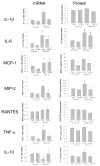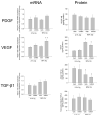Vitamin A and retinoic acid act synergistically to increase lung retinyl esters during normoxia and reduce hyperoxic lung injury in newborn mice
- PMID: 20220550
- PMCID: PMC2888037
- DOI: 10.1203/PDR.0b013e3181dbac3d
Vitamin A and retinoic acid act synergistically to increase lung retinyl esters during normoxia and reduce hyperoxic lung injury in newborn mice
Abstract
We have shown that vitamin A (VA) and retinoic acid (RA) synergistically increase lung retinyl ester content in neonatal rats. To confirm whether this biochemical synergism attenuates early neonatal hyperoxic lung injury in mice, we exposed newborn C57BL/6 mice to 95% O2 or air from birth to 4 d. The agent [vehicle, VA, RA, or the combination vitamin A+retinoic acid (VARA)] was given orally daily. Lung and liver retinyl ester content was measured, and lung injury and development were evaluated. We observed that lung, but not liver, retinyl ester levels were increased more by VARA than by VA or RA alone. Hyperoxic lung injury was reduced by VA and RA, and more so by VARA. VARA attenuated the hyperoxia-induced increases in macrophage inflammatory protein (MIP)-2 mRNA and protein expression, but did not alter hyperoxia-induced effects on peptide growth factors (PDGF, VEGF, and TGF-beta1). The 4-d exposure to hyperoxia or retinoids did not lead to observable differences in lung development. We conclude that the VARA combination has synergistic effects on lung retinyl ester concentrations and on the attenuation of hyperoxia-induced lung injury in newborn mice, possibly by modulation of inflammatory mediators.
Figures




Similar articles
-
VARA attenuates hyperoxia-induced impaired alveolar development and lung function in newborn mice.Am J Physiol Lung Cell Mol Physiol. 2013 Jun 1;304(11):L803-12. doi: 10.1152/ajplung.00257.2012. Epub 2013 Apr 12. Am J Physiol Lung Cell Mol Physiol. 2013. PMID: 23585226 Free PMC article.
-
Vitamin A combined with retinoic acid increases retinol uptake and lung retinyl ester formation in a synergistic manner in neonatal rats.J Lipid Res. 2006 Aug;47(8):1844-51. doi: 10.1194/jlr.M600061-JLR200. Epub 2006 May 9. J Lipid Res. 2006. PMID: 16685080
-
The components of VARA, a nutrient-metabolite combination of vitamin A and retinoic acid, act efficiently together and separately to increase retinyl esters in the lungs of neonatal rats.J Nutr. 2006 Nov;136(11):2803-7. doi: 10.1093/jn/136.11.2803. J Nutr. 2006. PMID: 17056804 Free PMC article.
-
Inflammation induced by lipopolysaccharide does not prevent the vitamin A and retinoic acid-induced increase in retinyl ester formation in neonatal rat lungs.Br J Nutr. 2013 May 28;109(10):1739-45. doi: 10.1017/S0007114512003790. Epub 2012 Sep 5. Br J Nutr. 2013. PMID: 22950813 Free PMC article.
-
Retinoic acid combined with vitamin A synergizes to increase retinyl ester storage in the lungs of newborn and dexamethasone-treated neonatal rats.Neonatology. 2007;92(1):26-32. doi: 10.1159/000100083. Epub 2007 Feb 23. Neonatology. 2007. PMID: 17596734 Free PMC article.
Cited by
-
Vitamin A Transport Mechanism of the Multitransmembrane Cell-Surface Receptor STRA6.Membranes (Basel). 2015 Aug 28;5(3):425-53. doi: 10.3390/membranes5030425. Membranes (Basel). 2015. PMID: 26343735 Free PMC article. Review.
-
Effect of Hyperoxia on Retinoid Metabolism and Retinoid Receptor Expression in the Lungs of Newborn Mice.PLoS One. 2015 Oct 28;10(10):e0140343. doi: 10.1371/journal.pone.0140343. eCollection 2015. PLoS One. 2015. PMID: 26509921 Free PMC article.
-
Thyroid hormone modulates hyperoxic neonatal lung injury and mitochondrial function.JCI Insight. 2023 Apr 24;8(8):e160697. doi: 10.1172/jci.insight.160697. JCI Insight. 2023. PMID: 36917181 Free PMC article.
-
A critical regulatory role for macrophage migration inhibitory factor in hyperoxia-induced injury in the developing murine lung.PLoS One. 2013 Apr 29;8(4):e60560. doi: 10.1371/journal.pone.0060560. Print 2013. PLoS One. 2013. PMID: 23637753 Free PMC article.
-
Paradoxical effects of all-trans-retinoic acid on lupus-like disease in the MRL/lpr mouse model.PLoS One. 2015 Mar 16;10(3):e0118176. doi: 10.1371/journal.pone.0118176. eCollection 2015. PLoS One. 2015. PMID: 25775135 Free PMC article.
References
-
- Ambalavanan N, Carlo WA. Bronchopulmonary dysplasia: new insights. Clin Perinatol. 2004;31:613–628. - PubMed
-
- Shenai JP, Chytil F, Stahlman MT. Vitamin A status of neonates with bronchopulmonary dysplasia. Pediatr Res. 1985;19:185–188. - PubMed
-
- Darlow BA, Graham PJ. Vitamin A supplementation to prevent mortality and short and long-term morbidity in very low birthweight infants. Cochrane Database Syst Rev. 2007 CD000501. - PubMed
-
- Tyson JE, Wright LL, Oh W, Kennedy KA, Mele L, Ehrenkranz RA, Stoll BJ, Lemons JA, Stevenson DK, Bauer CR, Korones SB, Fanaroff AA. Vitamin A supplementation for extremely-low-birth-weight infants. N Engl J Med. 1999;340:1962–1968. - PubMed
-
- Ambalavanan N, Ross AC, Carlo WA. Retinol-binding protein, transthyretin, and C-reactive protein in extremely low birth weight (ELBW) Infants. J Perinatol. 2005;25:714–719. - PubMed
Publication types
MeSH terms
Substances
Grants and funding
LinkOut - more resources
Full Text Sources
Medical

